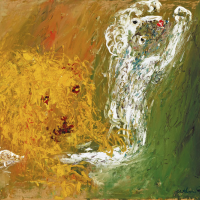89. ARTHUR BOYD

Arthur Boyds Nebuchadnezzar paintings of the late 1960s form one of the defining series of his career. Following the success of his seminal Brides in 1958-59, Boyd moved to London where he continued to create darkly mythic paintings, culminating in the Nebuchadnezzar series. Boyd collaborated with Oxford historian T. S. R. Boase to create the 1972 publication Nebuchadnezzar. The book included a concise history of Nebuchadnezzar, the biblical king of ancient Babylon, written by Boase, and thirty-four paintings by Boyd illustrating a descent into madness.1 The theme proved extraordinarily fruitful for Boyd, who produced many depictions of Nebuchadnezzar, including the present work White Nebuchadnezzar with Lion c1966-68.
The story of Nebuchadnezzar comes from the Book of Daniel in the Old Testament. Written in the second century BCE, the Book of Daniel is a biblical apocalypse set in the sixth century BCE. The fourth chapter details the reign of Nebuchadnezzar, who ruled Babylon from 604 to 561 BCE.2 Nebuchadnezzars long reign was one of almost continuous success, with numerous tablets attesting to his well-founded government and his passion for building.3 According to one legend, Nebuchadnezzar built great terrace gardens for his wife, Queen Amytis, known as the Hanging Gardens of Babylon - later regarded by the Ancient Greeks as one of the Seven Wonders of the Ancient World.4
However, with this success came Nebuchadnezzars downfall, as he became intoxicated by his own power. As punishment for his pride and arrogance, he purportedly lost his sanity and was cast into the wilderness for seven years where he, dwelt with the beast of the field.5 It is the story of Nebuchadnezzars mad sojourn into the wilderness that captured Boyds imagination, using the Australian bush as a desolate backdrop for the kings physical and psychological turmoil. These intense, frenzied and fundamentally literary works, are in sharp contrast to his serene Shoalhaven and Wimmera landscapes. Instead of calm vistas of water, land and sky, the Nebuchadnezzar works highlight an extraordinary range of religious, apocalyptic, and emotive imagery.
The words that spoke most directly to the artist are those where Nebuchadnezzar is described as:
driven from men, and did eat grass as oxen, and his body was wet with the dew of heaven, till his hair was grown like eagles feathers, and his nails like birds claws his heart was made like the beasts, and his dwelling was with the wild asses.6
It is in this liminal state between man and beast that Boyd depicts Nebuchadnezzar in the present work, almost taking the form of a lamb attacked by a lion. Here, we see the lion in pursuit of a master it no longer recognises. Like a lion, says the legend, Nebuchadnezzar attacked and killed men. Now he has become the prey to wild beasts.7 In the tale, the lion eventually shows mercy, and his sympathy brings a semblance of restored humanity to the outcast ruler. It is easy to see how this dramatic saga inspired Boyd to create the thrilling painting, White Nebuchadnezzar with Lion.
Footnotes:
1. Boase, T. S. R., Nebuchadnezzar: 34 Paintings and 18 Drawings by Arthur Boyd, Thames & Hudson, London, 1972
2. Ibid., p.24
3. Ibid., p.30
4. Ibid.
5. Ibid.
6. Daniel 4:33, as quoted in Ibid., p.42
7. Ibid., pl.28
Asta Cameron